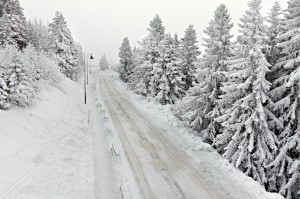Winter Driving Tips to Help You Avoid a Car Accident
By Daniel E DAngelo Esq on November 27, 2013
Winter weather blew into Denver, Colorado last Thursday and with it the official start of the winter driving season.
Snow covered roads, blowing snow, ice, and freezing rain can cause challenging driving conditions, which make the winter weather driving more dangerous than any other seasonal conditions. The best way to avoid a car accident when the winter road conditions get bad is to not drive. However, if you must drive in winter weather conditions, here are a few tips to help you avoid a car accident:
Buy a heavy duty ice scraper or two with a brush and use it. A good ice scraper only costs between $10.00 to $20.00 on Amazon. Everyone hates scraping the snow and ice off their car on a cold winter morning, but trying to drive while peeking out a small peephole through the snow and ice covering your windshield is dangerous and you might (should) get a ticket. Do everyone on the road a favor by clearing all your car windows, hood, roof, and car lights of any snow and ice. Flying snow from the hood of your car can obstruct your visibility and snow left on your car can distract and obstruct the vision of anyone behind you. If your headlights and brake lights aren’t visible you can’t see and other drivers are less likely to see you. To make scraping easier, park your car facing east or in a spot that gets the first morning sun to help melt any snow and ice on your car. Also, if you know a storm is coming, leaving your windshield wipers pulled out away from the windshield will keep them from freezing to your windshield.
Leave early, leave more space, and slow down. Most people already know these rules, however it’s one of the best ways to help prevent car accidents in winter weather. You may think these rules do not apply if you grew up driving in Colorado or some other wintery location (I grew up in upstate New York) or you drive an SUV or all wheel drive car, however, that is not the case. Remember SUVs and all wheel drive cars are not immune to sliding on ice, snow, and wet roads. There are also many other drivers on the road who may not be used to driving in winter weather, and slowing down will give them a break. Taking it slow means more than decreasing your driving speed. You should also brake, turn, and accelerate more slowly to decrease the chance of slipping and sliding.
Basic driving dkills. When possible, brake ahead of curves, accelerate after curves, and steer with your foot off the brake. If you have ABS brakes (anti lock braking system) don’t pump your brakes when you begin to slide, keep the ball of your foot firmly pressed on the brake. If your back tires begin to slide, turn in the direction your tires are sliding. If your front tires begin to slide sideways, take your foot off the accelerator and once you start to regain control, turn in the direction you want to go and accelerate gently. You may also want to use the first snow fall to practice your winter driving skills in a big empty parking lot.
Use the Proper Tires. If you drive a lot in winter conditions, then winter or snow tires may be cost effective option for you. Winter tires are designed to perform better in winter’s lower temperatures and their deeper treads are designed for snow, slush, and ice. Winter tires will improve traction and will maximize your braking efficiency and handling. Regularly check your tire pressure to help get the maximum performance from your tires. Studded tires are also an option for more grip on ice.
No cruise control. Using cruise control in wet, snowy, or icy winter conditions can increase the likelihood of losing control in slippery conditions. Because your foot is not on the accelerator while cruise is engaged you’re less likely to notice when the car is beginning to slide and you are more likely to slam on the brakes making the situation worse.
Put an emergency bag or kit in your vehicle. This tip doesn’t help you avoid an accident, but will come in handy if you are stuck in the snow or your breaks down. Extra winter clothes, gloves, hats, and a blanket(s) will help keep you warm. You may also want to put in some winter boots if you get stuck and need to walk in deep snow or slush. Jumper cables, an ice scraper (see above), small shovel, windshield wiper fluid, and a bag of sand or cat litter to put under your tires for traction can also be helpful. If you have a baby or kids, extra diapers, wipes, water, and snacks may help you avoid also having to handle a crying and upset kiddo.



